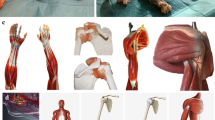Abstract
Purpose
We aimed to evaluate the quantity and quality of current evidence concerning the outcomes of use of plastinated specimens in anatomy education.
Methods
We performed a narrative literature review, searching for papers dealing with the use of plastination in anatomy education. PubMed, Scopus, ERIC, Cochrane, Web of Science and CINAHL complete electronic databases were searched. The following data were extracted: author(s), year of publication, type of study (comparative or not), number of participants, evaluation of statistical significance, educational outcomes and their level according to Kirkpatrick hierarchy.
Results
Six studies were eligible for analysis. Five of them evaluated only students’ reactions about plastination and one study also assessed their examinations results. There were four non-comparative and two comparative studies. Only a study evaluated statistical significance (p < 0.05) with higher score of perception in 2nd year undergraduate medical students, who were more familiar with plastination in comparison to 1st year students. Although the use of plastination was accompanied by positive outcomes in the majority of studies (five out of six), this method was not proved superior to traditional cadavers dissection.
Conclusions
The existing evidence about the outcomes of the use of plastination in anatomy education is relatively limited and lacks comparative studies with statistical significant results. Positive students’ reactions were generally noted, but further research is needed to clarify if plastination could be of benefit to students’ attitude and anatomy knowledge.

Similar content being viewed by others
References
Abou Hashem Y, Dayal M, Savanah S, Štrkalj G (2015) The application of 3D printing in anatomy education. Med Educ Online 20:10
Azu OO, Peter AI, Etuknwa BT, Ekandem GJ (2012) The awareness of medical students in Nigerian Universities about the use of plastinated specimens for anatomical studies. Maced J Med Sci 5(1):5–9
Baker EW, Slott PA, Terracio L, Cunningham EP (2013) An innovative method for teaching anatomy in the predoctoral dental curriculum. J Dent Educ 77(11):1498–1507
Bernal-Mañas CM, González-Sequeros O, Moreno-Cascales M, Sarria-Cabrera R, Latorre-Reviriego RM (2016) New anatomo-radiological findings of the lateral pterygoid muscle. Surg Radiol Anat 38(9):1033–1043
Bhandari K, Acharya S, Srivastava AK, Kumari R, Nimmagada HK (2016) Plastination: a new model of teaching anatomy. Int J Anat Res 4(3):2626–2629
Brenner E, Maurer H, Moriggl B, Pomaroli A (2003) General educational objectives matched by the educational method of a dissection lab. Ann Anat 185(173):229–230
Cook P (1997) Sheet plastination as a clinically based teaching aid at the University of Auckland. Acta Anat 158:33–36
Dhanwate AD, Gaikwad MD (2015) Plastination—a boon to medical teaching & research. Int J Sci Res 4(5):1550–1553
Estai M, Bunt S (2016) Best teaching practices in anatomy education: a critical review. Ann Anat 208:151–157
Fasel JH (1988) Use of plastinated specimens in surgical education and clinical practice. Clin Anat 1:197–203
Fruhstorfer BH, Palmer J, Brydges S, Abrahams PH (2011) The use of plastinated prosections for teaching anatomy—the view of medical students on the value of this learning resource. Clin Anat 24(2):246–252
Hammick M (2000) Interprofessional education: evidence from the past to guide the future. Med Teach 22(5):461–467
Haque ATME, Haque M, Than M, Khassan LHBM, Ishak AMB, Azmi ADBN, Rezal MADB (2017) Perception on the use of plastinated specimen in anatomy learning among preclinical medical students of UNIKL RCMP, Malaysia. J Glob Pharm Technol 9(9):25–33
Jadhav A, Kulkarni PR, Chakre G (2016) Plastination: a novel way of preserving tissues. Al Ameen J Med Sci 9(4):212–214
Jones DG, Whitaker MI (2009) Engaging with plastination and the Body Worlds phenomenon: a cultural and intellectual challenge for anatomists. Clin Anat 22(6):770–776
Kirkpatrick DI (1967) Evaluation of training. In: Craig R, Mittel I (eds) Training and development handbook. McGraw Hill, New York, pp 87–112
Koslowsky TC, Berger V, Hopf JC, Müller LP (2015) Presentation of the vascular supply of the proximal ulna using a sequential plastination technique. Surg Radiol Anat 37(7):749–755
Latorre RM, García-Sanz MP, Moreno M, Hernández F, Gil F, López O, Ayala MD, Ramírez G, Vázquez JM, Arencibia A, Henry RW (2007) How useful is plastination in learning anatomy? J Vet Med Educ 34(2):172–176
McRae KE, Davies GA, Easteal RA, Smith GN (2015) Creation of plastinated placentas as a novel teaching resource for medical education in obstetrics and gynaecology. Placenta 36(9):1045–1051
Neha Lalwani S, Dhingra RJ (2013) Plastinated knee specimens: a novel educational tool. Clin Diagn Res 7(1):1–5
Oppermann J, Franzen J, Spies C, Faymonville C, Knifka J, Stein G, Bredow J (2014) The microvascular anatomy of the talus: a plastination study on the influence of total ankle replacement. Surg Radiol Anat 36(5):487–494
Papa V, Vaccarezza M (2013) Teaching anatomy in the XXI century: new aspects and pitfalls. Sci World J 2013:310348
Rath B, Notermans HP, Franzen J, Knifka J, Walpert J, Frank D, Koebke J (2009) The microvascular anatomy of the metatarsal bones: a plastination study. Surg Radiol Anat 31(4):271–277
Riederer BM (2014) Plastination and its importance in teaching anatomy. Critical points for long-term preservation of human tissue. J Anat 224(3):309–315
Sora MC, Jilavu R, Matusz P (2012) Computer aided three-dimensional reconstruction and modeling of the pelvis, by using plastinated cross sections, as a powerful tool for morphological investigations. Surg Radiol Anat 34(8):731–736
Von Hagens G, Tiedemann K, Kriz W (1987) The current potential of plastination. Anat Embryol 175:411–421
Funding
None.
Author information
Authors and Affiliations
Contributions
DC and MP designed and wrote the paper. They equally contributed to the study. EOJ edited the paper. GT and AM collected the data. GCB, VSN and KK contributed to the discussion of the data. KN edited and finally revised the paper.
Corresponding author
Ethics declarations
Conflict of interest
The authors declare that they have no conflict of interest.
Ethical approval
Not applicable.
Additional information
Publisher's Note
Springer Nature remains neutral with regard to jurisdictional claims in published maps and institutional affiliations.
Rights and permissions
About this article
Cite this article
Chytas, D., Piagkou, M., Johnson, E.O. et al. Outcomes of the use of plastination in anatomy education: current evidence. Surg Radiol Anat 41, 1181–1186 (2019). https://doi.org/10.1007/s00276-019-02270-3
Received:
Accepted:
Published:
Issue Date:
DOI: https://doi.org/10.1007/s00276-019-02270-3




